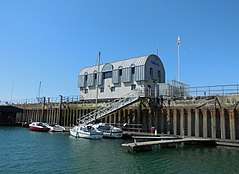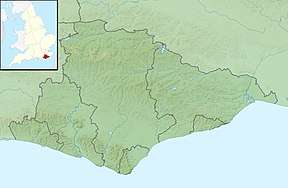Brighton Lifeboat Station
Brighton Lifeboat Station is an RNLI[2] station located in the town of Brighton in the English county of East Sussex in the United Kingdom.[3] The station currently operates as an inshore lifeboat station but was originally a station for an all-weather lifeboat, however this boat was withdrawn in 1931.[4] The original station was established in 1825.[4] The current lifeboat (2014) is the Atlantic 85 RNLB Random Harvest (ON 852)
| Brighton Lifeboat Station | |
|---|---|
 | |
 Brighton Lifeboat Station (Now under re-development[1]) | |
 Location of Brighton Lifeboat station within East Sussex | |
| General information | |
| Type | RNLI Lifeboat Station |
| Architectural style | Steelframe Boathouse with brick and block construction |
| Location | Brighton Marina, East Sussex, BN2 5UF |
| Country | England |
| Coordinates | 50°48′39.6″N 0°06′15.4″W |
| Opened | 1825 - 1931 re-established in 1965 |
| Owner | Royal National Lifeboat Institution |
| Technical details | |
| Material | Concrete, brick, block and Steel |
Location
The station is located in the marina area of the town and is co-ordinated from HM Coastguards at Lee-on-Solent.[5] Being an inshore station, the majority of the station's services are within two miles[5] of the station, often to leisure boats or beach-goers who have got into difficulties. The station is, on average, called to service sixty[5] times a year. The present boathouse and station facilities were constructed and opened in 2000 at a cost of £299,775.[4]
History
The National Institution for the Preservation of Life from Shipwreck, the fore-runner of the RNLI, first opened a lifeboat station in Brighton in 1824. The lifeboat supplied to this inaugural service was kept in a cave close to the Chain Pier. This was the first time that a lifeboat had been housed in a cave in Britain and the service operated from here until 1837, following the construction of the great Madeira sea-wall and Madeira Drive[6] which had begun 1830.[7] In 1837[8] the lifeboat was withdrawn from the town and it was not until 1858 that another station was opened in the town.
The 1858 station
The town council provided an area on the beach for a new boathouse.[8] The site was opposite the Bedford Hotel close to the West Pier.[8] The station operated from this site until 1868[8] when it was once again moved to a new location on the beach close by. In 1886 further improvements and alterations to the seafront in Brighton including the re-location of the station following the erection of groynes on the beach. The new station was located on the Western Esplanade, between the two piers, inside two of the spacious arches that were being constructed as part of the seafront re-developments at this time. Arch No. 109[9] was used to house the RNLI’s lifeboat whilst 110 was used to store all the equipment. In arch No. 111 the town council operated their own lifeboat. The site was used continually until 1931 when the RNLI withdrew the all-weather boat from the town as a result of the nearby Shoreham being equipped with a new motor lifeboat. These arches are now occupied by Brighton Sailing Club[9] but there is a, now unreadable plaque,[9] on the wall between arches 109 & 110 records the Robert Raikes,[10] the first RNLI lifeboat of 1867. This lifeboat replaced the three lifeboats[10] which until 1867 had operated in the town. The lifeboat was named after Robert Raikes, the founder of the Sunday School movement, because this boats funding had come from a collection made by the towns Sunday School children who had collected £580[10] towards its cost. On the back wall of one of the arches there still remains a large ring[9] anchored into the masonry. This was used to pull the lifeboat back into the arch.
Inshore Lifeboat
Following the withdrawal of cover in 1931[8] the town had no lifeboats for 34 years until an Inshore lifeboat was sent to the town in 1965. This inflatable D-class boat was kept in an arch under the promenade to the east of the Palace Pier. The lifeboat was funded from donations made by the patrons of a public house in London called The Rising Sun. This lifeboat was withdrawn before the winter of 1974 and the station was closed in 1975. This closure was to be a temporary measure until work was completed on the new Brighton Marina where new lifeboat facilities were included in the plans. During 1977 the station remained open but was none operational and this time was spent on training the crew and staff ready for the station to become operational. In 1978 the station re-opened within the new marine development where a pontoon was provided for the RNLI at the cost of £10,000.[8] The stations inshore lifeboat was kept afloat, and did not become fully operational until 1979. The lifeboat now had a small shelter constructed alongside the pontoon which gave the new Atlantic 21 Lions International (B 539) some protection. Inside the shelter the lifeboat was housed on a slipway. In 1981 a more permanent boat house was constructed and a temporary shelter was installed on the nearby quayside to house the crew facilities. The station had the distinction of becoming the institute’s first floating lifeboat station.[8] In 1997 the station was provided with a larger Atlantic 75 lifeboat called Thelma Glossop (B 737).[11] The new lifeboat arrived on the station on 1 July of that year.
Improvements
In 1999 work began on the construction of new shore facilities for the station on the quayside within the marina. The work was completed in 2000 at a cost of £299.775.[12] In January 2014 the stations facilities were closed down and the station was moved to temporary accommodation a short distance away. The building (Picture in the Information Box) erected in 2000 was demolished as part of the £235 million[1] re-development and expansion of the Brighton marine. These plans include the building of a new station close to the old location. This new station will include enhanced facilities for the crew and a souvenir shop to help with the institutes fund raising activities Location Template
Awards
From the earliest days of lifeboat services at Brighton, numerous medals and other awards have been presented,[13] including -
- 1824 Silver Medal to Charles Watts for the rescue of three people
- 1838 Silver Medal to Lieutenant E. Franklin RN for the rescue of eight crew from the brig Friends
- 1839 Silver Medal to Lieutenant E. Franklin RN for the rescue of six crew from the brig Zebra
- 1840 Gold Medal to Captain Digby Marsh RN
- 1840 Silver Medal to Lieut N Newman RN
- 1840 Silver Medal to Lieut T H Prior RN
- Note: the three 1840 rescues were 22 saved from the brig Mary, schooner Sire John Seale and brig Offerton
- 1998 Walter and Elizabeth Groombridge Award
Neighbouring Station Locations
References
- "Brighton RNLI relocates while bigger, better base is built". News about the re-location of the lifeboat station. The Argus © 2014. Retrieved 10 April 2014.
- "Brighton Lifeboat Station – RNLI website". Home page of the Brighton station. RNLI © 2014. Retrieved 28 March 2014.
- OS Explorer map 122: Brighton and Hove. Scale: 1:25 000. Publisher:Ordnance Survey – Southampton B2 edition. Publishing Date:2009. ISBN 978 0319240816
- "Brighton Lifeboat – A Brief History". Reference to Historic Dates concerned with the station. Brighton Lifeboat Station © 2014. Archived from the original on 13 April 2014. Retrieved 5 April 2014.
- "A Little More About What We Do". Information about the workings of the station. Brighton Lifeboat Station © 2014. Archived from the original on 13 April 2014. Retrieved 7 April 2014.
- A Guide to the Buildings of BRIGHTON. Author: Royal Institute of British Architects. Publisher: McMilllan Martin Ltd. Work: page 58 The Seaside, Reference to the development of Madeira Drive. ISBN 1869865030
- "History of Madeira Drive - Brighton". Details and history of Madeira Drive. This Brighton © 2014. Retrieved 8 April 2014.
- For Those In Peril – The Lifeboat Service of the United Kingdom and the Republic of Ireland, Station by Station. Author: Leach, Nicholas. Publisher: Silver Link Publishing Ltd, First Issue 1999. Work:Part 2, South Coast of England – Eastbourne to Weston-super-Mare, Page 72, Brighton Lifeboat Station. ISBN 1 85794 129 2
- "Brighton Sailing Club - History". References to the Lifeboat Station in the Arches. Brighton Sailing Club. Archived from the original on 2 March 2009. Retrieved 7 April 2014.
- "Lifeboats - First established in 1825". Information about the history of Brighton’s Lifeboats. Retrieved 7 April 2014.
- "B-class Atlantic 85 Production List". List of the RNLI fleet of B-class Atlantic 85 ILB including B-737. All rights reserved © 2014 NavyNuts. Retrieved 10 April 2014.
- "Brighton Lifeboat Station – RNLI website". Reference within the History tab on the home page. RNLI © 2014. Retrieved 28 March 2014.
- "RNLI Brighton - Our history". Archived from the original on 29 November 2014. Retrieved 21 November 2014.